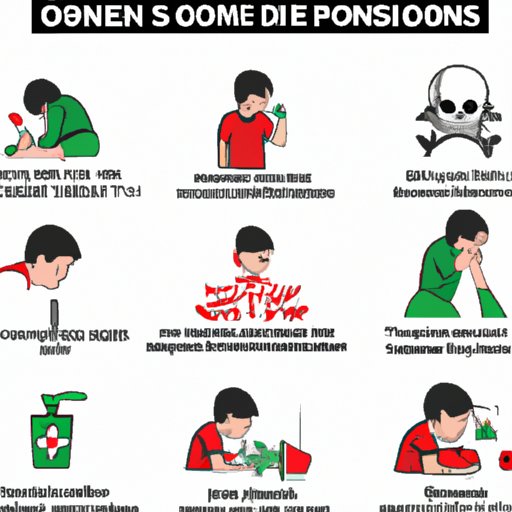
Introduction
Cyanide poisoning is a serious medical emergency that can happen when a person is exposed to high levels of cyanide, a fast-acting and potentially lethal poison. Recognizing the symptoms of cyanide poisoning is crucial because prompt treatment is key to reducing its potentially life-threatening effects. This article will provide a comprehensive guide to the symptoms of cyanide poisoning, how to recognize them, and what to do next if you suspect you or someone you know has been exposed to cyanide.
7 Signs of Cyanide Poisoning You Need to Know About
The seven common signs or symptoms of cyanide poisoning include headache, confusion, dizziness, shortness of breath, rapid heart rate, nausea and vomiting, and loss of consciousness. These symptoms can occur within minutes to hours following exposure to cyanide and can be fatal if left untreated.
Headaches are a common symptom of cyanide poisoning and can be accompanied by confusion and dizziness. The sudden onset of shortness of breath and rapid heart rate can indicate that the body is not getting enough oxygen, which can lead to respiratory failure. Nausea and vomiting can occur as the body attempts to rid itself of the poison. Loss of consciousness is the final symptom of cyanide poisoning and is often seen in severe cases.
Real-life examples or scenarios can help to better understand each symptom. For instance, a person who has been mistakenly exposed to cyanide while working in a chemical factory may experience headache, confusion, and dizziness soon after exposure. If left untreated, these symptoms can quickly progress to shortness of breath and rapid heart rate, which can lead to serious consequences.
Cyanide Poisoning: How to Recognize the Symptoms
To recognize the symptoms of cyanide poisoning, it’s important to understand the different ways that cyanide can enter the body. Cyanide can be ingested, inhaled, or absorbed through the skin, and the symptoms can vary depending on the method of exposure.
Some tips for recognizing the symptoms of cyanide poisoning in others include changes in behavior or appearance, such as confusion, slurred speech, or difficulty breathing. Other signs that may be present include an unusual odor on the skin or breath, a cherry-red color to the skin or lips, or seizures or convulsions.

When Deadly Cyanide Strikes: Symptoms and Treatment Options
When a person is exposed to lethal levels of cyanide, it can quickly lead to metabolic acidosis, which is a condition in which the body’s cells are unable to produce energy. Symptoms of cyanide poisoning can progress rapidly from mild to severe, and prompt treatment is essential for preventing serious consequences.
There are different types of treatment options available for cyanide poisoning, including antidotes and supportive care. Antidotes work by binding to the cyanide molecules in the body and preventing them from causing further damage, while supportive care involves providing oxygen, fluids, and other treatments to stabilize vital signs and promote recovery.
Prompt treatment is crucial for preventing serious consequences, which can include coma, respiratory failure, and death.
What are the Symptoms of Cyanide Poisoning? A Comprehensive Guide
The symptoms of cyanide poisoning can include both early and late-stage symptoms. Early symptoms may include headache, dizziness, shortness of breath, and nausea, while late-stage symptoms may include seizures, loss of consciousness, and respiratory failure.
Cyanide poisoning can affect different areas of the body, including the respiratory system and the cardiovascular system. Inhaled cyanide can cause rapid breathing, chest pain, and respiratory distress, while ingested cyanide can cause abdominal pain, vomiting, and diarrhea. Over time, cyanide poisoning can lead to cardiopulmonary failure, which can be fatal if left untreated.
Examples and case studies can illustrate the range of symptoms that may occur in different situations. For instance, a person who has accidentally ingested cyanide while eating a contaminated food product may experience abdominal pain and vomiting within a few minutes to hours of ingestion. Other symptoms may include headache, confusion, and dizziness, which can quickly progress to seizures, coma, and respiratory failure.
Cyanide Poisoning: How to Identify the Warning Signs
Identifying the early warning signs of cyanide poisoning can be crucial for preventing serious consequences. Some early warning signs may include headache, nausea, confusion, or shortness of breath.
If you suspect that you or someone you know has been exposed to cyanide, it’s important to seek medical attention immediately. First aid measures, such as removing contaminated clothing and administering oxygen, may help to prevent further damage before professional medical help arrives.
From Headaches to Death: A Look at the Different Stages of Cyanide Poisoning
The different stages of cyanide poisoning can be characterized by a range of symptoms that progress over time. Early symptoms may include headache, confusion, and dizziness, while late-stage symptoms may include seizures, loss of consciousness, and deep coma.
Recognizing the different stages of cyanide poisoning is crucial for providing effective treatment. In the early stages of cyanide poisoning, treatment may involve removing the person from the source of exposure and providing supportive care, such as oxygen and fluids. In later stages, more aggressive treatment may be required, such as the administration of antidotes or the use of mechanical ventilation to support breathing.
Symptoms of Cyanide Poisoning: What to Look For and What to Do Next
To sum up the main points of the article, recognizing the symptoms of cyanide poisoning is crucial for preventing serious consequences. If you suspect that you or someone you know has been exposed to cyanide, it’s important to seek medical attention immediately and provide first aid measures if possible.
A checklist of the key symptoms to look for if you suspect cyanide poisoning may include headache, dizziness, shortness of breath, rapid heart rate, nausea and vomiting, loss of consciousness, and seizures or convulsions.
The key to preventing serious consequences is to act quickly and seek medical attention as soon as possible.
Conclusion
Cyanide poisoning is a serious medical emergency that can happen when a person is exposed to high levels of cyanide. Recognizing the symptoms of cyanide poisoning is crucial because prompt treatment is key to reducing its potentially life-threatening effects. By knowing how to recognize the symptoms of cyanide poisoning, you can help to prevent serious consequences and potentially save lives. Be sure to share this information with your friends and family to help spread awareness about the importance of recognizing the symptoms of cyanide poisoning.




